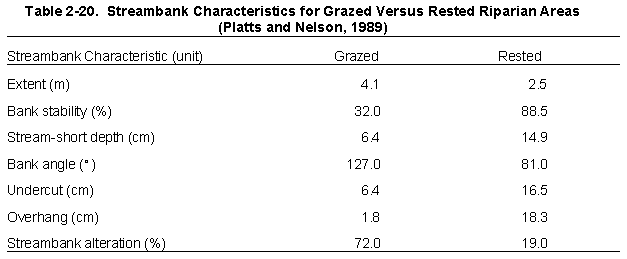
US EPA. 1993. Guidance Specifying Management Measures for Sources of Nonpoint Pollution in Coastal Waters. EPA-840-B-93-OOLC, US EPA, Office of Water, Washington, D.C.
| To the previous article | To the next article |
Grazing management systems have been highly ignored in the United States, which is probably due to the large amount of available land. Now that the agricultural land base is shrinking and farmers are experiencing financial problems, grazing management systems are beginning to get some attention. This form of management applies to pasture, range, and other grazing lands used by domestic livestock. Grazing management focuses on the riparian zone and encourages the control of erosion land above the riparian zone. In order for these systems to work they must fit the needs of the terrain, type of livestock, and vegetation (Murphy, pp. 227). Also, areas need to be provided for animal watering and shading that are located away from the riparian zone when this is feasible. Limiting livestock access to various parts of the land can also be important in the management system. This is usually done by fencing or excluding the animals from a portion of the land. These grazing management systems will result in a reduction of physical disturbances in sensitive areas and a reduction in the discharge in sediment, animal waste, nutrients, and chemicals to surface waters (EPA, 1993).
According to the EPA (1993) some grazing management system practices are as follows:
1. Deferred grazing: postponing grazing for a certain period of time in areas with bare ground or low ground cover. This will allow the vegetative cover to increase, which results in increased filtering capabilities and a greater uptake of nutrients.
2. Planned grazing: performed with two plots of land and allowing one to rest while the other is in use.
3. Proper grazing use: grazing at a rate that will maintain enough cover to protect the soil and improve the quality of vegetation. This increased vegetation acts as a sediment filter and slows runoff.
Alternate water supply practices that will ease the strain of the riparian zone (EPA, 1993):
1. Pipelines: decreases sediment, nutrient, and organic pollutants from livestock by giving them another water source.
2. Trough or tank: provide drinking water for livestock, which allows for a greater distribution of animals over the land.
3. Pond: trap sediments and nutrients that wash into the basin.

 |